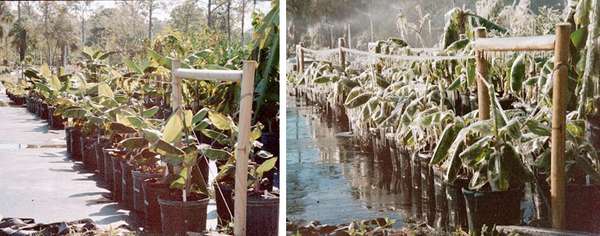From ECHO's Farm: Freeze Protection
Published
2023-02-07
Every year in the winter months of December to March at ECHO Florida, we enter the potential for frost and freeze events. While our sub-tropical climate allows us to grow most tropical plants, a frost or freeze event could mean serious impacts for future yields or even the survival of more sensitive plants. Thankfully there are several strategies we employ to help protect the farm on those cold nights.
Pre-event Preparations
Two to three days before a cold weather event, it is important to make sure your soil moisture level is at or near field capacity. Wet soil can hold more heat than dry soil, therefore when we keep our soil wet, we maximize the amount of heat we can store. While impractical on a large scale, another method to increase soil temperatures is to pull back mulch from the base of the plants. This allows more solar radiation to enter the soil, thereby storing more heat. This is most effective for annuals where the crop is not covering the soil. The stored heat is then released during the cold night, creating a microclimate near the plant. This can be just enough to avoid any frost, especially when this strategy is used in conjunction with frost cloth.
Frost Cloth
Before sundown on the evening of a frost event, we cover plants that are cold-sensitive with frost cloth. Frost cloth acts as a blanket, trapping heat that is released from the soil. It is important to keep the frost cloth from directly touching the plant leaves, as any leaves touching the frost cloth can be damaged by the cold. It is also important that the frost cloth extends to the ground on all sides, as the heat will escape if there are openings. Weighing down the frost cloth and securing it with clips is a must if you want the cloth to stay in place all night, especially in windy conditions.
Irrigation
On nights when freezing temperatures occur, and weather conditions permit, we utilize our overhead and micro-spray irrigation systems to encase plants in ice. While this method may seem counterintuitive, ice encasement can be a very effective method of freeze protection. This method works provided we continually introduce more water to the plant. As water turns from liquid to solid, it must release heat. This small amount of heat release is just enough to maintain a liquid water layer between the plant leaf surface and the ice. The irrigation system must be kept on until all the ice has melted off in the morning. A good understanding of psychrometrics and a reliable irrigation system is important to prevent damage to the plants.
A combination of these methods makes it possible for us to weather frost and freeze events with minimal damage. While not covered here, other management strategies such as farm design, protected agriculture, plant selection, and crop growth stages should be taken into consideration when growing in areas where cold weather conditions could adversely affect your crops. For more information on cold protection in agriculture, check out these helpful resources: http://edn.link/freezeprotection